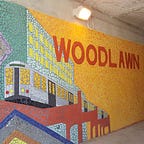Fear of gentrification in Woodlawn: Why it matters in the Obama center discussion
Depending on your point of view, Woodlawn may be gentrifying or may not be gentrifying. Despite a statement to the contrary, one can take a to take a look around east Woodlawn and see that new housing and retailers are indeed coming to the neighborhood after years of neglect.
The rate of new construction and demolition permits issued annually is increasing. The greatest number of building permits in Woodlawn since 2006 was seen in 2017, higher even than the pre-recession amount. Additionally, the most expensive single-family house was sold this year, and an even more expensive one — not even built — is now for sale.
One of the issues that scare long-time residents is not the addition of amenities — the need for local, quality retail has long been on our wishlist — but the ensuing higher rents and property taxes that accompany those amenities; in short, gentrification. The primary concern for Woodlawn residents I talked to in order to write this is if they are pushed out of this neighborhood, a Black neighborhood, where will people move next?
Where displaced residents might have to go is the point of view that decision makers, including President Obama himself, are working so hard to gloss over. Seeing that Chicago is one of the most racially and economically segregated cities in America, those fears are certainly well-founded.
You don’t have to live in Woodlawn to be aware that positive changes such as retail, employment, reduced crime and improving local schools needs to happen. At this point the Obama Presidential Center seems to be the catalyst for that change. I have yet to meet anyone who is against a Woodlawn revitalization. On the other hand I have met folks, specifically some of my neighbors, who are concerned that this positive change does not and will not include them.
Last week, the news of rising rents for the tenants of Jackson Park Terrace Apartments, an affordable housing complex directly across the street from the Obama Center, was reported. Almost simultaneously, a Community Benefits Agreement protest outside of Alderman Willie Cochran’s office occurred.
According to a speaker at the rally, effective April 1st, rents are supposed to rise $100-$200 a month after verbal assurances were made that an increase was not in the offing. This news has made nervous Woodlawn renters even more concerned about their long term future in the neighborhood as well as how their concerns are being woven into the Obama Presidential Center’s vision of community.
Take a moment and view the lens of change and gentrification through the eyes of a Black or Brown person, who make up over 90 percent of Woodlawn’s population.
If a renting family is pushed out of Woodlawn, where do they go? If they have a voucher, the task of renting in a low-crime neighborhood that accepts vouchers is a challenge. If they are market rate renters, their rental experiences may not fare any better. Rental discrimination is still very much alive in Chicagoland and there is a growing affordability gap between household incomes vs. the number of homes out there people can afford.
If you’re a homeowner, like I am, your options slightly increase but ultimately those options are still limited. The Obama Presidential Center and the influx of new residents seeking housing will more than likely make my property values rise. If I choose to sell, I’ll probably turn a profit.
Yet a major factor weighing on any of my future choices is will I be able to get a fair mortgage? Mortgage qualification encompasses a number of factors, but all things being equal, Black and Brown people have a much more difficult time securing mortgages, and when they do it is usually at a much higher cost. Add that to the fact that some Chicago neighborhoods where economic or racial diversity is not a priority are still not very welcoming.
To recap: If you’re a Black or Brown person and you’re forced to leave your rapidly gentrifying neighborhood, the likelihood of facing entrenched discrimination on several fronts is a real and distinct possibility. The fact that the fears of the most vulnerable to this displacement are being minimized and ignored should give everyone pause.
The current situation sends a signal that despite all of the lip service being paid to the idea that the Obama Presidential Center will be a beacon of inclusiveness and inspiration, its reality is far more insular and tone deaf.
